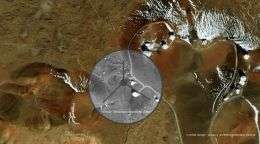Largest virtual telescope for short wavelengths opened

Astronomers have succeeded in combining three telescopes in Hawaii using advanced computer techniques. This virtual telescope, with a diameter of 782 metres, studies the formation of new stars and planets using light with a short wavelength (submillimetre). The Physical Sciences division of the Netherlands Organisation for Scientific Research (NWO) is one of the joint financiers of the Extended Submillimeter Array (eSMA). Louis Vertegaal, director of NWO Physical Sciences, will officially open the facility on Wednesday 12 November.
"The eSMA is an important overture to the Atacama Large Millimeter Array (ALMA) that will come into operation in Chile in 2013", says Louis Vertegaal, director of the Physical Sciences division of the Netherlands Organisation for Scientific Research (NWO). "The eSMA puts the Netherlands at the head of the field in the development of such submillimetre techniques. With the experience gained during work on the eSMA, Dutch astronomers should have a flying start when they have the opportunity to work with ALMA, eSMA's global 'brother' and twelve times bigger."
The submillimetre wavelength, also known as far-infrared, is light that is invisible to the human eye. It can penetrate dense clouds of interstellar dust and gas, which allows the telescope a clear view of the formation of new stars and planets. The eSMA is a unique device based on interferometry. A system of fibre-optic cables connects three existing telescopes, the 10-metre Caltech Submillimeter Observatory, the 15-metre wide, and partly Dutch, James Clerk Maxwell Telescope (JCMT) and the Smithsonian Millimeter Array that has eight six-metre dishes. Interferometry is a technique that has been used in radio astronomy for years, but its application at shorter wavelengths is considerably more difficult. The Dutch astronomer Remo Tilanus of the JCMT can endorse this: "The three observatories have had to work together closely to get this project off the ground and it's just fantastic that we are now seeing the first astronomical results." That the new facility can be found at the 4200-metre high summit of Mauna Kea is no coincidence: water vapour in the atmosphere blocks submillimetre radiation so these wavelengths can only be measured in locations with a low humidity and high altitude.
The scoop for the first scientific research results using the eSMA goes to Leiden Observatory. Post-doc Sandrine Bottinelli used the telescope to determine the ratio of atomic to molecular carbon in an extremely distant galaxy. This ratio is used as a standard for determining the degree to which interstellar clouds cool down and switch to star formation; moreover, atomic carbon is important in the formation of organic materials. "The results give us a glimpse of the chemical conditions of the young universe, about 6.5 billion years ago", says Bottinelli, "and they can tell us whether the conditions all that time ago were suitable, as they are now, for the synthesis of prebiotic molecules."
Source: Netherlands Organization for Scientific Research




















